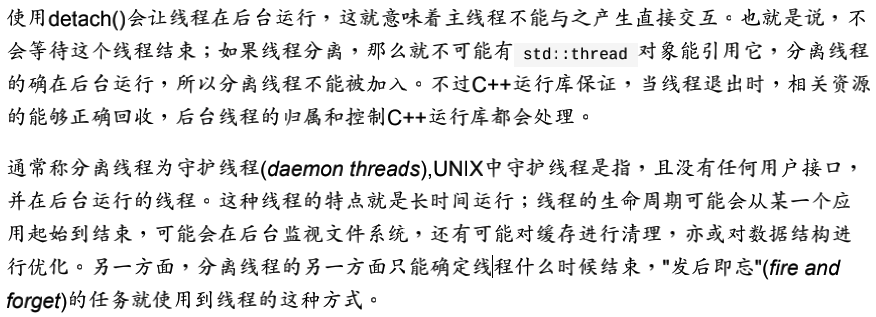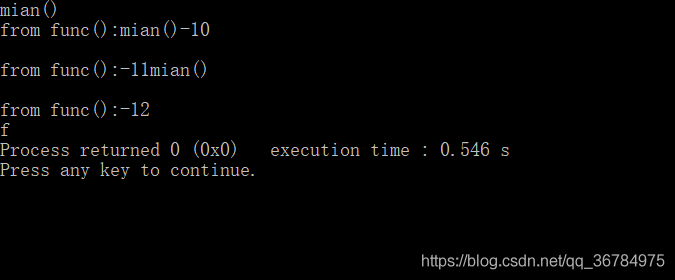blog.csdn.net
简介
每一个程序至少拥有一个线程,那就是执行 main()
函数的主线程,而多线程则是出现两个或两个以上的线程并行运行,即主线程和子线程在同一时间段同时运行。而在这个过程中会出现几种情况:
- 主线程先运行结束
- 子线程先运行结束
- 主子线程同时结束
在一些情况下需要在子线程结束后主线程才能结束,而一些情况则不需要等待,但需注意一点,并不是主线程结束了其他子线程就立即停止,其他子线程会进入后台运行
join()
join()函数是一个等待线程完成函数,主线程需要等待子线程运行结束了才可以结束

1
2
3
4
5
6
7
8
9
10
11
12
13
14
15
16
17
18
19
20
21
22
| #include <iostream>
#include <thread>
using namespace std;
void func()
{
for(int i = -10; i > -20; i--)
{
cout << "from func():" << i << endl;
}
}
int main()
{
cout << "mian()" << endl;
cout << "mian()" << endl;
cout << "mian()" << endl;
thread t(func);
t.join();
return 0;
}
|
 在这里插入图片描述
在这里插入图片描述
1
2
3
4
5
6
7
8
9
10
11
12
13
14
15
16
17
18
19
20
21
22
| #include <iostream>
#include <thread>
using namespace std;
void func()
{
for(int i = -10; i > -20; i--)
{
cout << "from func():" << i << endl;
}
}
int main()
{
thread t(func);
cout << "mian()" << endl;
cout << "mian()" << endl;
cout << "mian()" << endl;
t.join();
return 0;
}
|
 在这里插入图片描述
在这里插入图片描述
1
2
3
4
5
6
7
8
9
10
11
12
13
14
15
16
17
18
19
20
21
22
| #include <iostream>
#include <thread>
using namespace std;
void func()
{
for(int i = -10; i > -20; i--)
{
cout << "from func():" << i << endl;
}
}
int main()
{
thread t(func);
t.join();
cout << "mian()" << endl;
cout << "mian()" << endl;
cout << "mian()" << endl;
return 0;
}
|
 在这里插入图片描述
在这里插入图片描述
detach()
 image-20210601222337419
image-20210601222337419
1
2
3
4
5
6
7
8
9
10
11
12
13
14
15
16
17
18
19
20
21
22
| #include <iostream>
#include <thread>
using namespace std;
void func()
{
for(int i = -10; i > -20; i--)
{
cout << "from func():" << i << endl;
}
}
int main()
{
cout << "mian()" << endl;
cout << "mian()" << endl;
cout << "mian()" << endl;
thread t(func);
t.detach();
return 0;
}
|
 在这里插入图片描述
在这里插入图片描述
可以明显看到,主线程太快了,还没等子线程运行就结束了
1
2
3
4
5
6
7
8
9
10
11
12
13
14
15
16
17
18
19
20
21
22
| #include <iostream>
#include <thread>
using namespace std;
void func()
{
for(int i = -10; i > -20; i--)
{
cout << "from func():" << i << endl;
}
}
int main()
{
thread t(func);
cout << "mian()" << endl;
cout << "mian()" << endl;
cout << "mian()" << endl;
t.detach();
return 0;
}
|
 在这里插入图片描述
在这里插入图片描述
同样没等子线程运行完就结束了
1
2
3
4
5
6
7
8
9
10
11
12
13
14
15
16
17
18
19
20
21
22
| #include <iostream>
#include <thread>
using namespace std;
void func()
{
for(int i = -10; i > -20; i--)
{
cout << "from func():" << i << endl;
}
}
int main()
{
thread t(func);
cout << "mian()" << endl;
cout << "mian()" << endl;
cout << "mian()" << endl;
t.detach();
return 0;
}
|
 在这里插入图片描述
在这里插入图片描述
没等子线程运行完就结束
总结
如果想要分离一个线程,可以在线程启动后,直接使用
detach() 进行分离。如果打算等待对应线程,则需要细心挑选调用
join() 的位置。当在线程运行之后产生异常,在
join() 调用之前抛出,就意味着很这次调用会被跳过。
join()
函数是一个等待线程函数,主线程需等待子线程运行结束后才可以结束(注意不是才可以运行,运行是并行的),如果打算等待对应线程,则需要细心挑选调用
join() 的位置
detach()
函数是子线程的分离函数,当调用该函数后,线程就被分离到后台运行,主线程不需要等待该线程结束才结束







